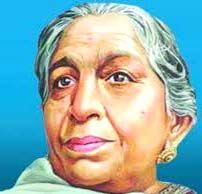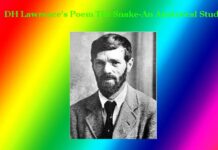The Poetry of Sarojini Naidu–Chief Features
The Poetry of Sarojini Naidu– Chief Features
The Poetry of Sarojini Naidu– Chief Features
Sarojini Naidu (1879-1949) was a versatile woman personality of twentieth-century India. She was a highly cultured woman, a freedom fighter, a theosophist and a poetess. As a poetess, she, after Toru Dutt, was a great Indo-Anglian career. She is especially a romantic poetess. The themes and imageries of her poetry are primarily Indian. Three loves- love for man, love for motherland and love for Nature are the main themes of her poetry. Her language is lyrical, alliterative, and full of individual similes. Moreover, her poems sometimes bend to mysticism. Indian myths and legends also meet in her poems with a romantic outlook.
Love is the primary theme of her poems. Her love poems are passionate to the point of eroticism. The poetess is very deep in love with her mate. In the poem ‘If You Call Me,’ she says that she is willing to have a call from her mate. She is very eager to meet and join her mate defying all the obstacles. She writes:
”If you call me, I will come
Swifter than desire,
Swifter than the lightning’s feet
Shod with plumes of fire.
Life’s dark tides may roll between,
Or Death’s deep chasms divide-
If you call me I will come
Fearless what betide.”
Her love poems remind us of Robert Burns’ ”My Love is Like a Red, Red Rose” in which the poet expresses his eager love for his beloved and determines to meet her anyway.
The bulk of her poems deals with the theme of Nature. Her Nature is full of trees, woods, birds, peace, freedom and beauty. She desires to take shelter in Nature being tired and wearied of man-made society and its artificiality. ‘Summer Woods ‘is a Nature poem dealing with such a tenet. In this poem he says:
”O I am tired of painted roofs and soft and silken floors,
………………………
I am tired of strife and song and festivals and fame
And long to fly where cassia woods are breaking into flame.”
In the same poem she says again:
”You and I together Love in the deep blossoming woods
Engirt with love-void silence and gleaming solitudes.
Companions of the lustrous dawn, gay comrades of the night
Like Krishna and like Radhika, encompassed with delight.”
‘The Bird Sanctuary’ is another poem dealing with the theme of love for Nature. In the poem, she says that Nature is a sacred place full of Joy, beauty and freedom. In the poetess’ language:
”In your gracious garden there is joy and fostering freedom
Nesting place and singing space for every fearhered thing,
O Master of the Birds, grants sanctuary and shelter
Also to a homing bird that bears a broken wing.”
The Poetry of Sarojini Naidu– Chief Features
The third theme of her poetry is her love to the motherland. The poetess is very aware of India’s slavery under the British and she is very passionate and emotional to free India from the yoke of the English. Sarojini Naidu believes that to get freedom, the people irrespective of caste and creed must come out. In the poem entitled ‘Awake’ she says:
”Waken, O mother, thy children implore thee,
Who kneel in thy presence to serve and adore thee!
The night is aflush with a dream of the morrow,
Why still dost thou sleep in thy bondage of sorrow?”
The Poetry of Sarojini Naidu– Chief Features
Besides those above analyzed themes, some of her poems are bent to mysticism though not apparently. Her heart and soul are so sensitive that she feels the human soul to be akin to the soul of Nature. Nature is the expression of the human soul as well as of the Divine Soul. In the poem Caprice she says:
”You held a wild flower in your finger tips,
Idly you pressed it to indifferent lips,
Idly you tore its crimson leaves apart…
Alas! It was my heart.”
The Poetry of Sarojini Naidu– Chief Features
Like a true mystic, she makes communication of her soul with the Divine Soul. In the poem ‘The Soul’s Prayer’ she shows to have communication with God and dramatically her soul speaks to and converses with the Divine Soul. The poetess seeks the solution to the mystery of life and death from God and God is shown to have said:
”I bending from my sevenfold height
Will teach thee of My quickening grace
Life is a prism of My light
And Death is the shadow of my face.”
In addition to the themes analyzed above, the poetess takes some themes and allusions from Indian myths and portrays them with a romantic outlook. ‘Songs of Radha Kanhaya’ and ‘Songs of Radha the Quest’ are some poems dealing with mythical themes. In ‘Songs of Radha Kanhaya ‘she speaks of Lord Krishna’s childish frolic. It is a poem dealing with the theme of the love of Radha for Krishna.
The linguistic style of Sarojini Naidu is lyrical, alliterative and full of similes. She often employs two-lined rhyme schemes (couplet) and sometimes uses the rhyme scheme as- ababcc of six lines. Her use of alliteration is praiseworthy. She uses it often with skill as- ”soft and silken”, “festivals and fame”, “praise and prayers” etc. She is very artful in the use of similes with a touch of novelty, such as-
(i)Seven queens shone round her ivory bed
Like seven soft gems on a silken thread.
(ii)Her glides and fillets gleam
Like charming fires on sunset seas.
(iii)A young queen eyed like the morning star.
The Poetry of Sarojini Naidu– Chief Features
Her imageries are also exquisite, though not often, but sometimes. For example, we can quote the following lines from the poem entitled ‘The Purdah Nashin’, as-
”From thieving light of eyes impure,
From coveting sun or wind’s caress
Her days are guarded and secure
Behind her cavern lattices:
Like jewels in a turbaned crest,
Like secrets in a lover’s breast.”
Sarojini Naidu as a romantic poetess is a combination of Wordsworth, Blake, Keats and Shelley with something of them in her though not in full. 0 0 0
The Poetry of Sarojini Naidu– Chief Features
N.B. The article ‘The Poetry of Sarojini Naidu– Chief Features’ originally belongs to the book ‘Indian English Poets and Poetry-Chief Features‘ by Menonim Menonimus.
Books of Composition by M. Menonimus:
- Advertisement Writing
- Amplification Writing
- Note Making
- Paragraph Writing
- Notice Writing
- Passage Comprehension
- The Art of Poster Writing
- The Art of Letter Writing
- Report Writing
- Story Writing
- Substance Writing
- School Essays Part-I
- School Essays Part-II
- School English Grammar Part-I
- School English Grammar Part-II..
Related Search:











